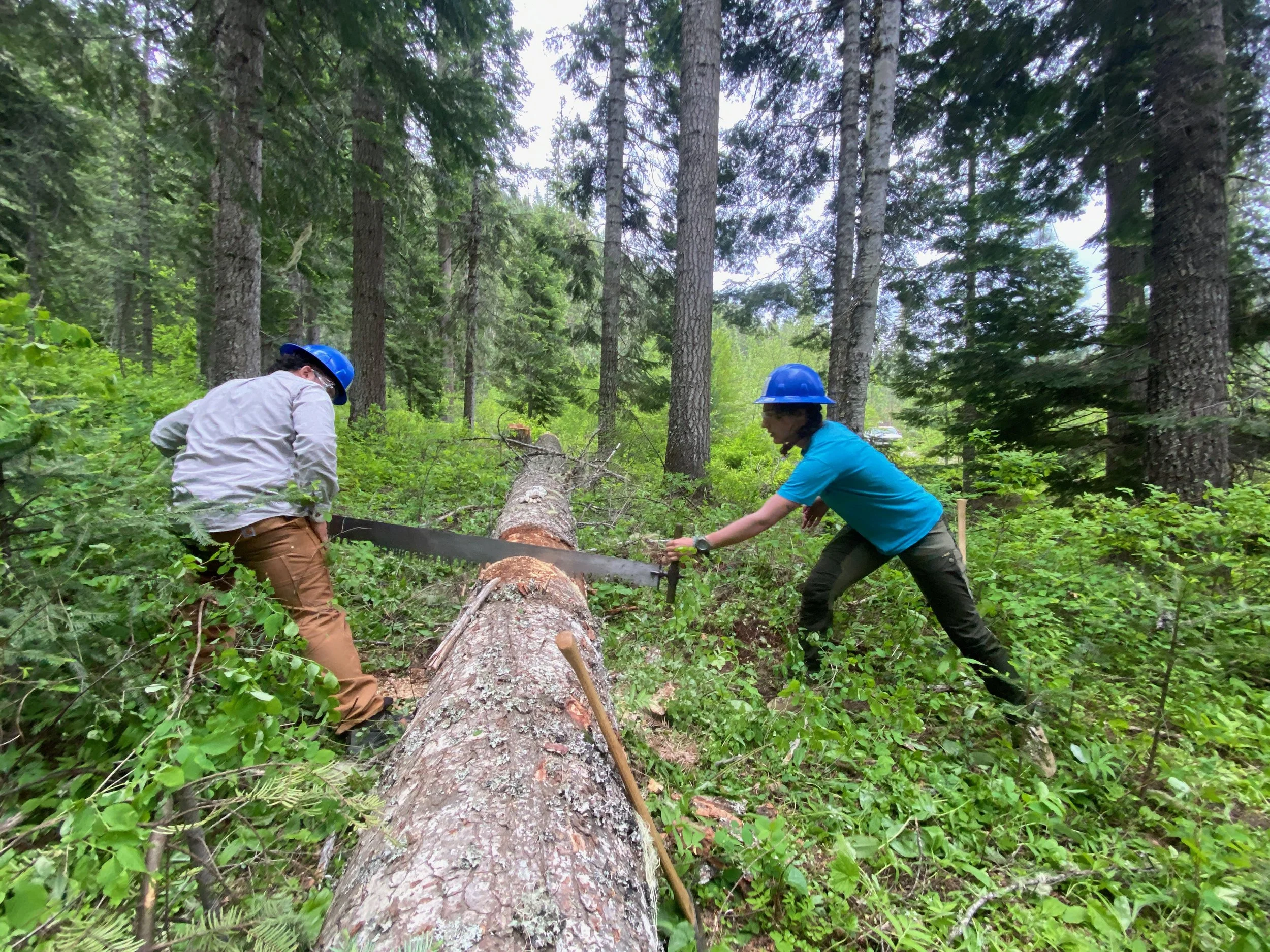Olivia Hinds
Wilderness Ranger Fellow
Training: Missoula and Powell Ranger Station
The past three weeks have been full of lots of training for us Wilderness Ranger Fellows. We’ve been stationed in Missoula, MT and Powell Ranger station to become Wilderness First Responders, ax and crosscut certified, and learned about the factors of wilderness character and how to exemplify them in the field. We are becoming equipped with the tools needed (no pun intended) to become fully fledged wilderness fellows and properly care for wilderness using traditional primitive tools.
This is near Powell Ranger Station in Lolo, ID. Pictured is Olivia Hinds and Wilderness Ranger Fellow Ariel Centeno practicing their freshly learned crosscut skills to become certified from the Northern Rockies Wilderness Skills Institute. Photo was taken by Forest Service member, Ben, stationed in Chamberlain, ID.
These trainings have really allowed us to bond and get to know each other. We have been working together as one massive crew rather than the small groups we will be split up into in just a weeks’ time. We live at the same RV resort park together (feels like home right now), work together, and recreate and explore together. We’ve gone out to recreate in places like Rattlesnake and Blue Mountain, chatted at coffee shops like Cat Clyde, gone climbing at Mills Creek, checked out Missoula’s world class library, and enjoyed the nightlife and live music scene in town at places like the Union. I am feeling grateful to be able to grow such strong bonds together and for the time we have been gifted to spend in Missoula. There are amazing people in this city’s community, as well as places to spend time outside and in town.
Here we are at Granite Peak RV Resort in Missoula where we have been camping for our training weeks. This is Oliva Hinds and crewmate Kieran Wilder practicing creating Swing and Swath arm wraps with materials we had available as part of our WFR homework. We used a car ice scraper, a book, and a fleece to wrap his arm. (Photo Credit: Heather Pendleton)
The thing that I did not expect was that we have begun applying our knowledge beyond our jobs and situations in the backcountry. We’ve started using WFR in every aspect of our day to day lives, taking the time to check in with one another and make sure we are okay, physically and mentally. This has also allowed us to practice team reasoning and problem solving outside of work hours. I myself even experienced this after a bad fall (pretty much a full yard sale with injuries across the frontal plane of my body) during a trail run at Rattlesnake Recreation Area. Once I regained composure, I immediately sat up on the trail and began assessing myself to see the damage. I went through my ABCDEs (airway, breathing, circulation, neurological deficits, and environmental conditions) to determine I had no life threats and the worst of my injuries included a sprained ankle and a large abrasion to my right knee.
I am excited to see our skills translate into the field, and to continue to build relationships with crewmates and greet fellows at the end of the season with stories and strength.
We’ve spent a good amount of time at our Wilderness First Responder training, learning that wilderness is not an easy place to exist without being aware. To remain safe in wilderness, we actively take risk management precautions and respond with what our instructor Leah likes to call “a can of calm” when necessary. We’ve grown closeness and trust in dealing with scenarios together, using each other as patients, and learning how to simultaneously take care of ourselves as well as others on our crew and people on the trails.
This is in Missoula College Montana where we reviewed our practical skills before the final day of WFR training where we practiced a mass casualty incident scenario. We reviewed litter carries, knots, splints and swing and swaths, cardiopulmonary resuscitation, implement stabilization, and wound treatments. Photo by Olivia Hinds.
This is along the Clark Fork River in Montana where we practiced some patient scenarios. These are SBFC staff members Dylan Barker and Peter Zimmerman getting into the acting to show off their fake impalement injuries. Photo by Olivia Hinds.
Nez Perce-Clearwater National Forest | Selway-Bitterroot Wilderness
Gonzaga University
Major: Biology
Olivia grew up in Star, Idaho and has always been an avid outdoor lover who likes to ski, climb, and run. Her experience includes working on a snorkel crew survey team with Idaho Fish and Game, trip leading, and researching salamander courtship gland morphology. After meeting two wilderness rangers in the Frank Church last summer, she was inspired to become one herself. She is interested in giving back Idaho’s public lands that she has spent so much time recreating on growing up through her passions of land management and outdoor education.





